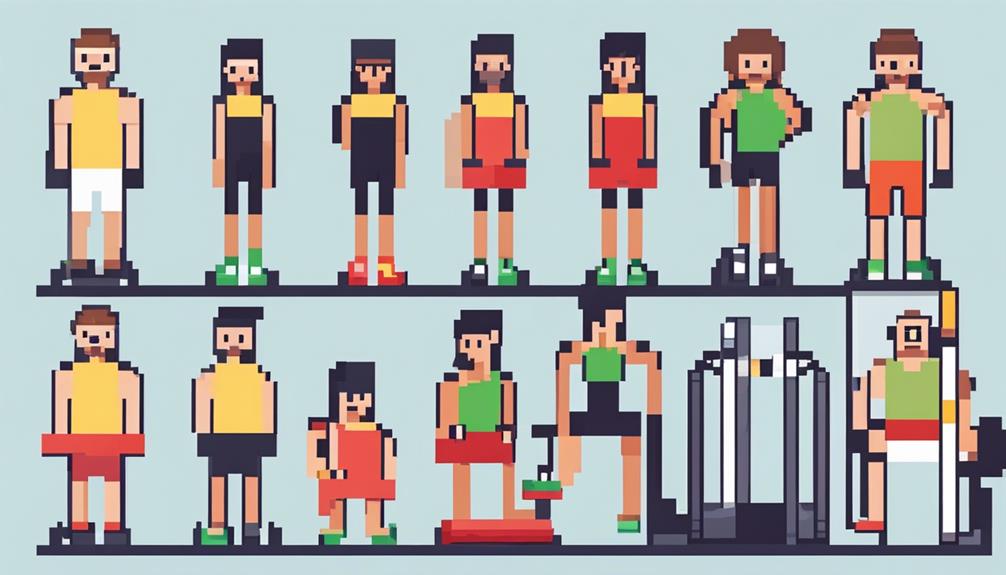Ready to kickstart your self-improvement journey? Begin by honing in on a niche that addresses real-life challenges in self-improvement. Define clear objectives to boost readership and income. Dive deep into your target audience's needs and interests for impactful content creation on productivity and wellness. Opt for user-friendly platforms like WordPress for customization. Establish a writing routine for consistency and growth. Foster a lively community through webinars, collaborations, and engaging with readers. Keep tabs on success metrics like traffic and engagement rates using tools like Google Analytics. Ready to reveal your potential through the power of blogging!
Key Takeaways
- Choose a profitable niche in self-improvement to solve real problems.
- Define clear objectives for increased readership and income.
- Establish target audience demographics and interests through market research.
- Develop a content strategy focusing on productivity and wellness topics.
- Select a customizable platform like WordPress for engagement tools.
Choosing Your Blogging Niche
When starting a self-improvement blog, start by identifying a profitable niche market that focuses on solving concrete problems and offering real solutions.
Personal development blogs thrive on providing helpful articles that address the specific needs of their audience through a problem-solving approach.
Niche profitability is key, so choose your niche wisely by avoiding being too broad and instead honing in on a specific area where you can make a significant impact.
Setting Clear Goals

Setting clear goals for your self-improvement blog is like setting a compass for your journey to success.
By defining your blogging objectives, establishing your target audience, and outlining a solid content strategy, you pave the way for meaningful growth and impact.
Define Blogging Objectives
Clearly outlining the goals of your self-improvement blog is essential for establishing a focused direction and achieving success in your blogging journey. When setting objectives for your blog, consider what you aim to achieve – whether it's increasing readership, earning income, inspiring others, or providing valuable personal growth tips.
Defining the purpose of your blog will guide your content creation strategy. Utilize measurable metrics like traffic growth, engagement rates, or sales conversions to track your progress towards these goals.
By having clear blogging objectives, you'll maintain consistency, stay motivated, and guarantee relevance in your posts. Remember, your goals act as a roadmap for your blog's success, helping you stay on track and measure your accomplishments along the way.
Establish Target Audience
Define your target audience by considering demographics, interests, and needs to set clear goals aligning with their preferences and expectations. Understanding your audience is crucial for the success of your self-improvement blog. Conduct thorough market research to grasp their behaviors and preferences. Tailor your content to address specific pain points and provide valuable solutions that resonate with them. Utilize analytics tools to track audience engagement, allowing you to adjust your strategies accordingly. Engaging with your target audience is key to building a loyal following and creating a community around personal growth.
| Demographics | Interests | Needs |
|---|---|---|
| Age | Hobbies | Guidance |
| Gender | Self-help books | Motivation |
| Location | Wellness activities | Support |
| Education level | Mindfulness | Strategies for growth |
| Occupation | Fitness | Time management |
Outline Content Strategy
Craft a focused content strategy for your self-improvement blog by establishing clear goals that align with your vision and purpose. Define specific objectives such as increasing personal growth insights and inspiring positive changes in your readers.
When outlining your content strategy, consider focusing on topics like productivity, wellness, and personal development to provide valuable insights and practical tips.
It's pivotal to set measurable goals like enhancing reader engagement and growing your blog's audience to monitor your progress effectively.
Tailor your content to cater to the needs and interests of your target audience, ensuring that your posts resonate with them and offer genuine value.
Regularly review and adjust your content strategy to maintain alignment with your goals and keep your audience engaged.
Selecting a Blogging Platform

When starting a self-improvement blog, consider exploring popular blogging platforms like WordPress, Blogger, or Medium. These platforms can help you reach a wider audience and engage readers effectively.
WordPress, powering 39.5% of all websites, offers customizable themes and plugins, allowing you to tailor your blog to suit your style and content.
Blogger, owned by Google, provides a simple interface and seamless integration with Google services, making it a convenient choice for beginners.
On the other hand, Medium is renowned for its clean design and emphasis on writing, attracting a built-in audience for potential exposure.
As you evaluate different platforms, focus on features like customization options, ease of use, and community engagement tools. These elements can help you create a blog that not only features stories aimed at self-improvement but also fosters interaction and discussion among your readers.
Choose a platform that aligns with your goals and offers the tools you need to make your blog successful.
Developing a Writing Routine

Ready to kickstart your self-improvement blog?
Start by establishing daily writing habits, ensuring consistency in your content creation.
Set achievable writing goals to keep you motivated and on track to deliver valuable and engaging posts for your readers.
Establishing Daily Writing Habits
To enhance your self-improvement blog's success, developing a consistent daily writing routine is essential. Here are some key tips to help you establish daily writing habits for your blog:
- Allocate Specific Time: Set aside dedicated time each day for writing to maintain a regular blogging schedule. Consistency is key in building a successful self-improvement blog.
- Create a Structured Routine: Establishing a writing routine fosters creativity, discipline, and productivity in blog content creation. Having a structured approach can help you stay focused and motivated.
- Enhance Quality and Quantity: Forming a habit of daily writing not only improves the quality but also increases the quantity of posts on your blog. This consistency will keep your readers engaged.
- Stay Committed: A structured writing routine enables you to stay committed to your personal growth blogging journey. It helps in maintaining your momentum and drive for continuous improvement in your content.
Consistency in Content Creation
Establishing a consistent writing routine is essential for maintaining a successful self-improvement blog. Developing a set writing routine helps you stay on track with your content creation goals. By dedicating specific time each day to writing, you can guarantee a steady flow of posts for your audience.
Consider creating a content calendar to plan and organize your blog topics in advance. This won't only help you stay organized but also secure that you have a clear direction for your content.
Consistent content creation is vital for engaging your readers and building a loyal audience. When you regularly publish quality posts, your readers will know what to expect from your blog and will be more likely to return for more.
Setting Achievable Writing Goals
Developing a writing routine involves setting achievable goals to maintain consistent content creation for your self-improvement blog. To effectively establish a productive routine, follow these steps:
- Set Specific Writing Goals: Commit to writing a certain number of blog posts per week to keep your content fresh and engaging.
- Create a Structured Schedule: Develop a daily or weekly writing schedule to make sure you dedicate time to your blog regularly.
- Utilize Content Calendars: Use tools like content calendars to plan ahead, organize your ideas, and stay on track with publishing dates.
- Monitor Your Progress: Keep track of your word count, post frequency, and engagement metrics to evaluate your writing goals' success.
Building a Community

Engage with your audience through various platforms to foster a sense of community around your self-improvement blog. By actively participating in discussions, responding to comments, and utilizing social media channels, you create a space where your community of readers can share their own experiences, provide feedback, and support one another on their self-improvement journeys.
Encouraging interaction and engagement not only strengthens the sense of community but also allows you to connect with your audience on a deeper level.
To further enhance community building, consider hosting webinars, workshops, or virtual events where your readers can engage with you and each other in real-time. Collaborating with other bloggers, influencers, or experts in the self-improvement niche can also help expand your reach and bring new perspectives to your community.
Offering exclusive content, resources, or membership options can incentivize readers to become more involved, fostering a loyal and engaged community around your blog.
Engaging With Readers

To foster a vibrant community around your self-improvement blog, actively encouraging reader engagement is key. Here are some effective ways to engage with your readers:
- Encourage Interaction:
Prompt readers to share their thoughts through comments, feedback, and discussions on your blog posts. Acknowledge their input and create a space for open dialogue.
- Utilize Social Media:
Extend your reach by using social media platforms to interact with your audience. Share blog updates, inspirational quotes, or behind-the-scenes content to keep them engaged and connected.
- Build Relationships:
Respond to reader inquiries and messages promptly. Show genuine interest in their questions or comments to establish trust and cultivate a loyal readership.
- Incentivize Participation:
Organize contests, challenges, or giveaways to spark reader participation. This not only boosts engagement but also adds an element of fun and excitement to your blog, making it more appealing to your audience.
Tracking Success Metrics

Monitoring success metrics is essential for evaluating the performance of your self-improvement blog and understanding the impact of your content and strategies. By tracking metrics such as traffic volume, engagement rates, conversion rates, and social media shares, you can gain valuable insights into what resonates with your audience and what areas need improvement.
Utilizing tools like Google Analytics allows you to explore deeper into the performance of your blog and identify patterns that can inform your content strategy.
Setting key performance indicators (KPIs) for each metric helps you stay focused on your goals and track progress effectively. Whether it's monitoring bounce rates to assess user engagement, analyzing time on page to gauge content effectiveness, or tracking click-through rates to measure conversion success, these metrics provide a detailed view of your blog's performance.
Frequently Asked Questions
How Do I Start a Self Improvement Blog?
Start by choosing your niche, hosting platform, and creating a content plan. Implement SEO techniques for visibility and engage with your audience through comments and social media. Consistent posting and community building are key.
Is Blogger Good Enough to Start a Profitable Blog?
Yes, Blogger is good enough to start a profitable blog. It offers basic features for beginners and integrates with Google services like AdSense for monetization. While lacking advanced features, many successful bloggers began their journey on Blogger.
What Is the Most Successful Type of Blog?
You want the most successful blog? Niched personal development blogs are gold mines! Offering concrete solutions to real problems hooks motivated readers. Focus on outcomes, not fluff. Move from vague motivation to problem-solving for success.
Which Type of Blog Make Money Is Best for Beginners?
For beginners, the best type of blog to make money focuses on a profitable niche market. Choose a niche that solves real problems and offers clear solutions. Emphasize concrete outcomes and problem-solving approaches to attract and monetize your audience effectively.
Conclusion
So there you have it, folks! Starting a self-improvement blog may seem challenging, but with the right mindset and tools, you can make it happen.
Remember, consistency is key, so keep posting regularly and engaging with your audience to see the best results.
And who knows, maybe one day your blog will be the go-to destination for all things personal development.
Keep blogging for better, and watch yourself grow!










